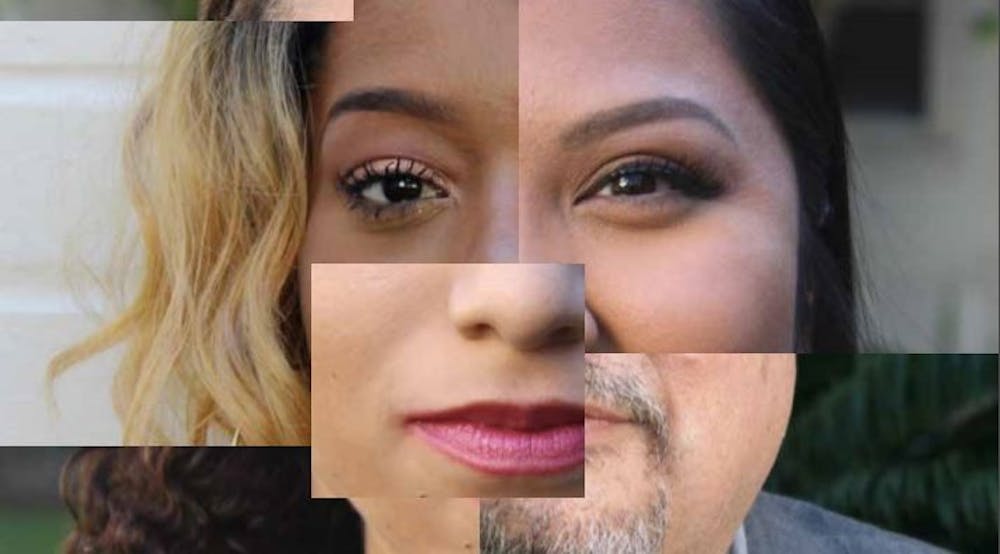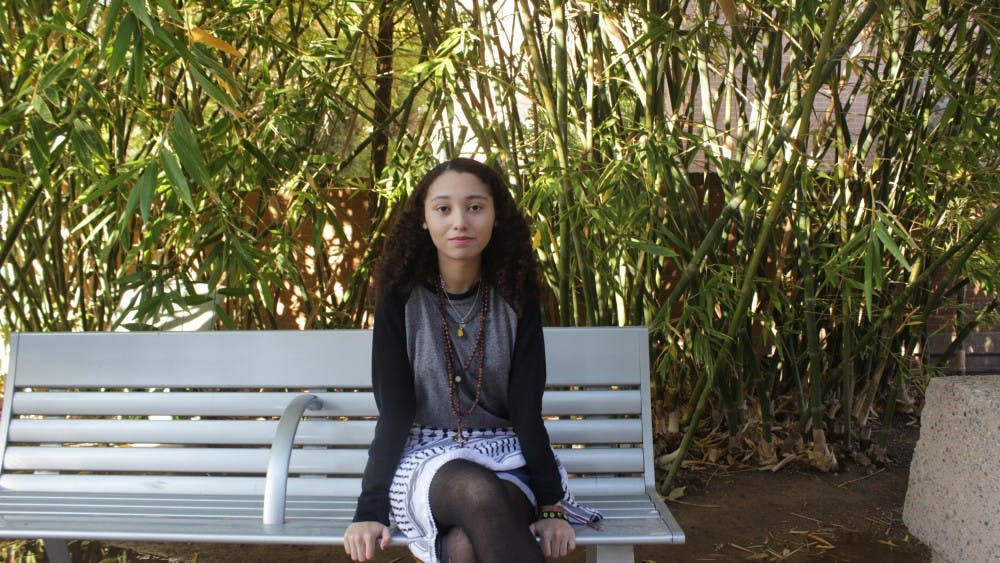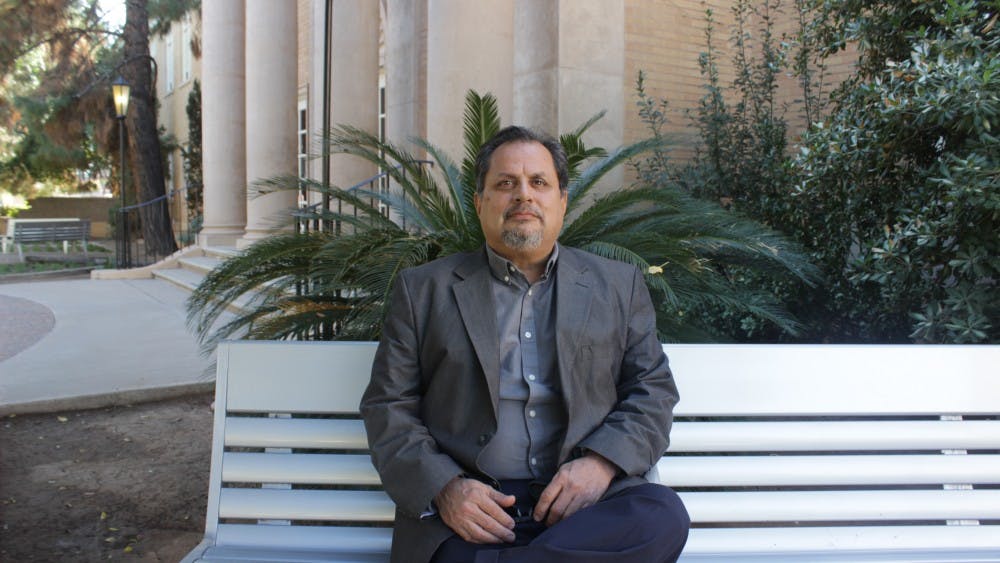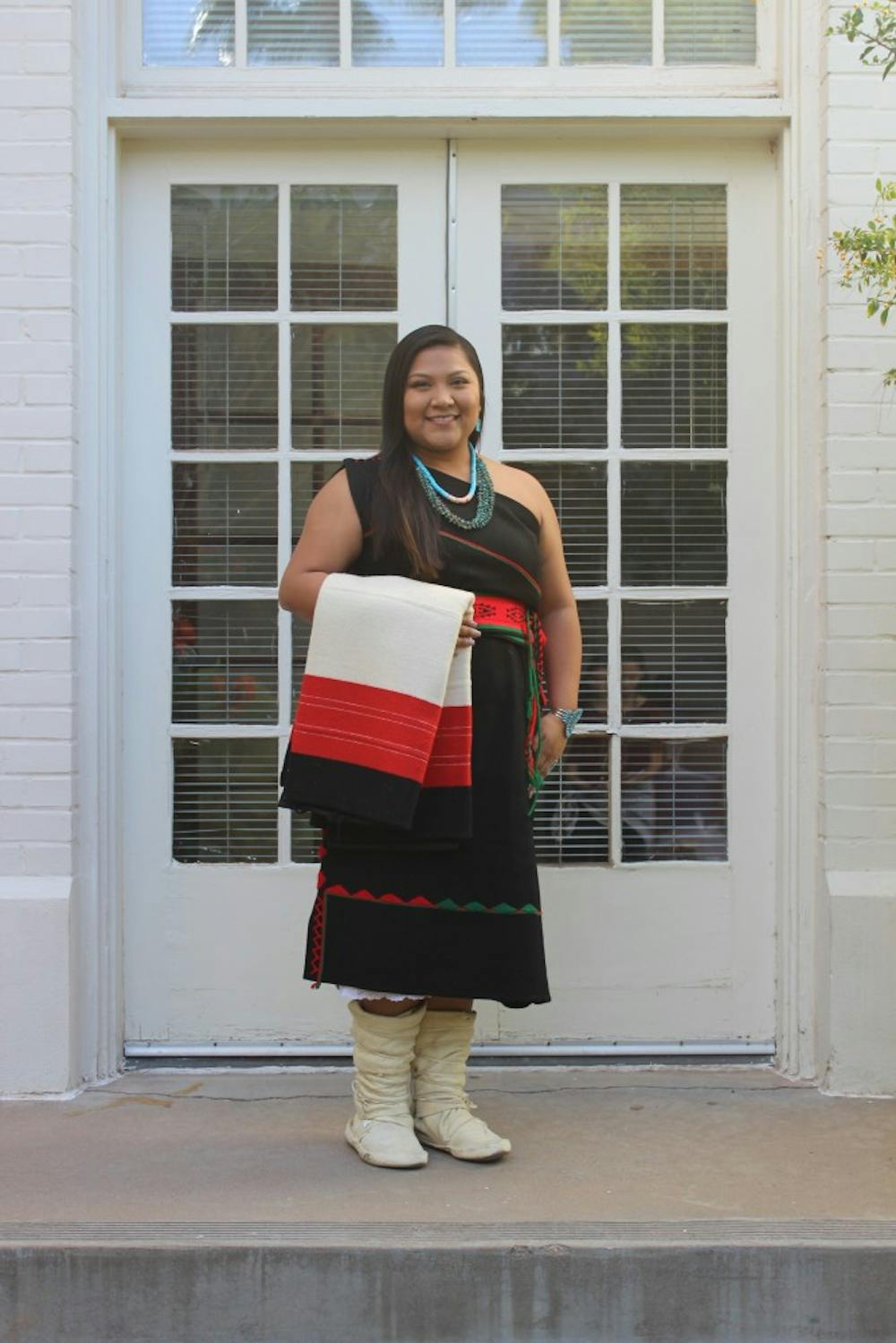Laila Kabongi
by Emily Taylor
Treasured elements of junior health sciences major Laila Kabongi's African and African American cultures are frequently appropriated in today’s world, from clothing, hairstyles and music.
“Bamboo earrings on a black girl are ghetto, but bamboo earrings at Urban Outfitters are chic and edgy,” Kabongi says.
She says her own experience with cultural appropriation has changed over time, especially since starting college. Being exposed to the world and witnessing appropriation firsthand has shown her how powerful it is to the entire black diaspora.
“(Cultural appropriation) is a form of exploitation,” Kabongi says. “Since I’ve realized people’s ignorance toward other cultures is so common, it doesn’t surprise me anymore. It still hurts me, of course, but does not surprise me.”
She defines cultural appropriation as people who do not identify as black, especially those who are not of the African diaspora, utilizing traditions, customs, clothing and hairstyles that are central to her culture.
Examples of this can be someone who is not a person of color wearing a traditional dashiki, or brightly colored tunic or shirt from Africa, or wearing dreadlocks, she explains.
Kabongi says she confronted people she felt were culturally appropriating in the past to break down how their actions or choice of style could be perceived as offensive to others.
“After having to do that, I question why I have to explain to them why they are being ignorant and why I should have to explain myself,” she says.
Seeing people appropriate elements of her culture, especially those on a larger stage, like celebrities, hurts because they are profiting off of black individuals, she says.
Kabongi was born in Nairobi, Kenya, but grew up in the United States after her family immigrated in search of political asylum.
She often interacted with people only in the African community because she could associate them with back home. It was not until recently that she says she is able to relate to African American culture, as well.
“Most of my friends that I have are African American, and we have similarities,” Kabongi says. “That was something I was never able to resonate with when growing up because I grew up African.”
Kabongi says cultural appropriation is a topic to be openly discussed because it is the only way the issue can be avoided.
“We have to talk about it or else it is going to keep happening,” Kabongi says. “That’s how you get people talking about what it is, how to avoid it and what the differences between appreciation and appropriation are.”
Kabongi says her views on cultural appropriation are all her own. She is speaking on behalf of herself and her own experiences as others’ may be different than hers.
Maria Harris
by Ranjani Venkatakrishnan
I've come across the term 'cultural appropriation' quite a few times since moving to the United States. Back in India, I never really thought about it. Honestly, I didn't even know it was something that existed. I've always thought it's important to learn about other cultures and the world. I've even invited friends from college over to my house for Indian festivals.
Then I found out about Coachella and how some people wear bindis to try to look "hipster."
To me, a bindi is the first symbol that a woman is Hindu. There's a strong meaning behind wearing it as well, as there is with most ancient Hindu traditions. It is supposed to protect the chakra point between our eyebrows and preserve the energy stored in us, and protect us from evil.
Knowing that non-Hindu people wear bindis without appreciating the meaning behind it, and just because it makes them look cool, infuriated me. That was cultural appropriation, and I didn't like it.
I talked about this with Maria Harris, a sophomore theater major. Born half-Mexican and half-African American, diversity is in Harris’ blood. Her diversity is further exemplified by having a Messianic Jewish mother and a Buddhist father.
“My dad’s Buddhist, and I guess in religion and culture I do identify with that a lot. See, I also wear a dharma wheel," Harris says, showing me a fingernail-sized silver dharma wheel necklace she wears around her neck.
Maria Harris says she feels strongly about cultural appropriation due to her multicultural identity.
“I think in the media, especially with music, it should be something that is talked about,” Harris says. “I also think that particularly the West is a melting pot, and, coming from a multicultural background, I obviously wouldn’t have a problem with people sharing cultures. But if you’re wearing someone else’s cultural outfit to make fun of them, that would be a problem.”
Harris mentioned over text that she read that both Hinduism and Buddhism have been synonymous with counterculture in America since the 1960’s with the Hippie movement. The counterculture movement originated from college campuses in the U.S., although it spread to other countries as well, and “rejected the mores of American life," opting instead to adopt practices from other cultures outside the West, according to the Encyclopedia Britannica.
Coachella is very similar in how it draws aesthetics from other cultures: a very hipster look, says Harris.
Harris texts me that over the last month she saw a lot of businesses use Buddhist phrases to sell services, such as “Bodhi Bowl,” a restaurant in downtown Los Angeles; “Credit Karma,” “Shangri-La Construction,” “Zen Dental” and “The Dolly Llama”.
Harris says she often thinks it’s cute when she sees names like these, such as “The Dolly Llama,” and she thinks there is usually some connection between the name and the service, although she isn’t really sure what zen has to do with dentistry. But, Harris says that her family actually went to Bodhi Bowl and it had a Buddhist vibe and she thinks the owner might be Buddhist.
“Granted, culture is fluid,” Harris says over text. “Just like gender. So again, it’s really hard to accuse someone of cultural appropriation.”
Editor's note: Maria Harris is a former State Press opinion columnist.
Louis Mendoza
by Emily Taylor
He grew up eating Tex-Mex cuisine and attending family reunions with 70 of his first cousins. He listened to mainstream American music and watched football as a pastime.
Fusing Mexican and American cultures was common practice for Louis Mendoza growing up as a Chicano in Houston, Texas.
“My culture was based on my everyday lived experiences and composed of a variety of things,” Mendoza says. “My grandparents on both sides of the family migrated to Texas from Mexico in the early part of the 20th-century. I was born and raised in the United States.”
Culture is still a pivotal concept in his life as he is the director of and a professor at Arizona State University’s School of Humanities, Arts and Cultural Studies.
Mendoza says language, food and celebration are all things that make his culture unique from others. Spanish is an integral part of his identity, despite it not being his first language. He says it is still an important part of his life because he grew up hearing it spoken by his parents and grandparents.
“I didn’t learn Spanish formally or fully as a child until high school and college,” Mendoza says. “It was still there in terms of certain concepts, ideas and values, though.”
Mendoza says Chicano consumer practices are also different from other cultures, especially in regard to food consumption. Mendoza says his home was stocked with some sort of Mexican food that was typically modified to be more American.
“It’s a combination of the cultural interactions that usually occur between places, history and the things that are available to you,” Mendoza says.
He says the observation of Dia de los Muertos, or Day of the Dead, is an example of how celebration is a central practice in his culture.
While it is often associated with painted sugar skulls, he says to him it is about giving loved ones who passed away a token of offering.
“It’s a way of bridging the living world with the afterlife,” Mendoza says. “There is a stronger sense of continuity between these two worlds. Your body may have changed, but you live on in different ways and have the legacy you left behind.”
Although his culture is strong in its traditions and values, he says cultural identity in the United States can be complicated due to the issue of race. If one’s culture is outside the majority, they are perceived differently by others.
Mendoza says the exchange of influences is common when people of different cultures coexist — however, it can be considered appropriation when aspects of a culture are exploited.
“There are a lot of commercial aspects of cultural appropriation with the companies that don’t arise from Mexican communities but try to market the culture,” Mendoza says.
He says the issue with this is that the companies do not have an authentic relationship to the culture and are ethnic exploiting. They try to cash in on it rather than have a genuine understanding of it.
Those who purchase objects from such businesses are participating in the cultural appropriation, Mendoza says.
He says there is nothing wrong with adopting elements of a culture, but it must be done with true appreciation and knowledge.
Mexican cultural appropriation can be seen in today’s food and music industry. Examples include Taco Bell and Justin Bieber’s remix of "Despacito."
“This goes to show that the rise and appreciation of cultural products are sometimes dependent on, for lack of better word, a white person making them legitimate,” Mendoza says.
He says appropriation can be seen on college campuses as well, such as when fraternities have culturally themed parties.
“It’s all about making fun of the culture rather than respecting it,” Mendoza says. “If they really had respect for it they would learn something more deeply about it rather than having a party.”
The topic of cultural appropriation is one that should be openly discussed because it is important for society to understand the complexities and sensitivities of different people, he says.
Mendoza says it important to be sensitive to cultural appropriation, but it is not about pointing fingers.
“It’s not about trying to say we should all live in our own silos and not have an appreciation, respect or knowledge of other cultures,” Mendoza says. “That’s what makes the United States unique.”
Daniell Albert
by Madison Staten
A member of the Hopi Tribe in Flagstaff, Arizona, Daniell Albert always knew she wanted to go to college. Despite moving schools frequently in her childhood, Albert’s parents instilled in her the importance of a quality education. So it was with a strong cultural foundation and love of education that Albert, now a junior in the interdisciplinary studies program, came to Arizona State University in the fall of 2015.
Albert credits her success at ASU to the large population of Native American students at the university for helping her to find relatable friends who share similar passions. While her time at ASU has been an overall positive experience, Albert has had to educate some of her peers concerning a few cultural misconceptions.
“I think the biggest thing that people misinterpret is that I’m going to ASU for free ... that the government pays for everything,” Albert says. “That’s not true. I have to apply for the same scholarships as anyone else. I have to pay the same tuition.”
Combating these stereotypes through her own actions as a ASU student, Albert wants to bring further awareness to the many elements of Native American culture. Her hope is for more people to understand the differences between tribes, leading to fewer generalizations and stereotypes.
“My thoughts on Native American elements based on pop culture makes me want to express who I am, my culture and the symbolic meaning behind the ‘costumes,’ and that not all Native American tribes are the same,” Albert followed up in a written statement. “Each tribe and nation is unique, we speak different languages and represent ourselves in such a different way.”
Albert continued by saying that as a Hopi woman, she prides herself on learning about cultural traditions that have been passed down through multiple generations and, despite living in the 21st century, values traditional elements from her tribe.
She explained that it can be hard to bridge the cultural gap with teachers, especially when she has to give nonspecific answers about sacred cultural traditions.
“We have our traditions that happen annually, so when I have to talk to teachers about it and say this is why I have to miss class, or this is why I have to leave so early, it can be hard to explain,” Albert says. “I have to just say it’s a ceremony. I can’t go into depth about it because within the tribe you have to be initiated to know the depths of it.”
Albert is working hard to discredit the theory that most Native Americans are passive and quiet.
“I think some believe that because I’m Native American I’m quiet, and I sit in the corner and don’t talk to anyone,” Albert says. “But it’s not true. Me as a person, I’m really outgoing, I’m talkative, I’m just like everyone else.”
Her bubbly personality is just one of the many qualifications that helped her to be awarded her position as the 2017-18 Miss Indian ASU 1st Attendant at the annual Mr. and Miss Indian ASU pageant. She’s now using her voice to speak up about the importance of secondary education institutions, traveling to speak with high school students from many different reservations across Arizona.
“When you see these kids growing up on the reservation they don’t have the resources, they don’t have the money to come to campuses, they don’t have the money to go on tours,” Albert says. “Bringing those resources to them, gives them a better chance to realize they can go to college, that they can do this.”
At the end of the day, Albert believes it is about giving kids an opportunity to reach their full potential.
“It’s not just about the money,” Albert says. “It’s the fact that people are out there, that a kid can say, ‘Someone wants me to go here and they believe in me.’ That’s the attitude I want to spread and that is why I want to go to the students. To let them know that I understand where they’re coming from.”
At a recent conference, her high school counselors asked her to speak to a group of high schoolers and offer life advice.
“I went up to the panel and I had to think of something really quick,” Albert says. “I remembered this essay that I had written in one of my classes. It was about the importance of corn. Within my culture, corn is really central to our traditions. It brings life to each and every one of us.”
Though she wrote the essay in high school, Albert continues to live her life with the words in mind and strives to share their meaning with the younger generation.
“Each student is corn. We need to remember our roots. We need to remember our nourishment and our sun and our water,” Albert says. “What I mean by that is we think about our roots we need to remember what keeps us grounded. ... Our sun and our water is our nourishment, so that’s what keeps us growing. The nourishment could come from goals or accomplishments. It could come from your mom and dad. It’s the things that give us nourishment and love. The things that will help us to grow.”
Reach the magazine at statepressmag@gmail.com and follow @madisonmstaten, @emily_a_taylor, and @RanjPhoenix on Twitter.
Like State Press on Facebook and follow @statepresss on Twitter.








